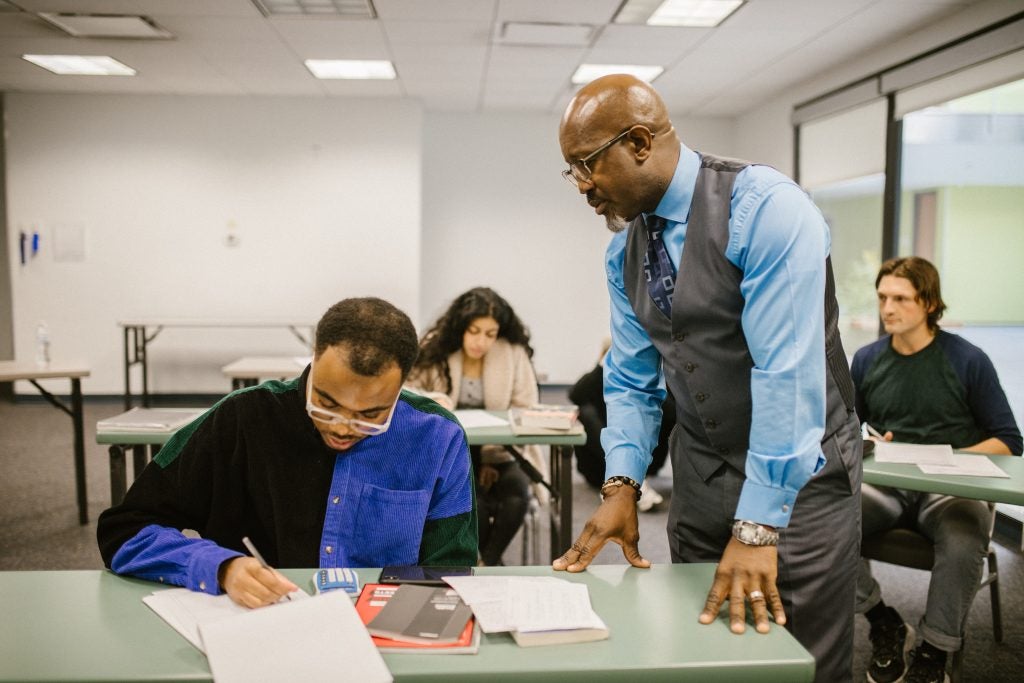Module 1: High School vs. College (Part 3)
Classes and Instructors
Introduction
Objective: The student will identify key differences between high school and college and apply this to their personal expectations and goals.
This is the second lesson in a series of high school/college comparisons in Module 1.
Estimated time 30-45 minutes
Materials needed:
No materials needed for this lesson.
Classroom Curriculum Link:
This section corresponds with Module 2 Lesson 2 of the College Bond classroom resources.

Learn About It- Classes and Instructors
- Part 2 of High School vs. College will touch on key differences between the high school and college settings regarding classes and instructors.
- Ask family members or other acquaintances who have attended college to tell stories about experiences related to this lesson. Or, simply talk with family members about what you think the implications will be for each comparison in the information provided.
High School vs. College: Classes
| Contrast | Implications |
|---|---|
| Class Schedule High School: Students follow a school-directed schedule and are told how to spend their time. College: Students (along with their advisors) create their own schedules and manage their own time. | – Time management is one of the most important skills for you to learn. – Most high school students receive a great deal of guidance on developing and following a daily schedule, (i.e., what they should be doing and when). – In college, you will have numerous activities, events, and assignments vying for your time. It’s easy to fall behind very quickly due to poor time management. |
| Class Attendance High School: Class attendance is mandatory and monitored. College: Attendance policies vary by professor. | – Many incoming and first-year college students are under the impression that students do not need to attend classes in college because professors don’t take attendance. – However, many colleges have an official attendance policy, and professors may choose to follow that attendance policy or use their own. In many college classes, students are allotted a specific number of absences for the semester, and students who exceed that number of absences fail the class. In addition, professors generally don’t offer make-up tests and are unlikely to review missed information. Therefore, even if there is no formal absence penalty, the missed information, missed assignments, and impact on teacher impressions can affect student grades. See “Parents Chime In” below regarding class attendance. |
| Class Size High School: Classes usually do not have more than 30–35 students. College: Class size may range from 5 students to more than 100 students. | – The size of your classes often depends on the size of your college. Smaller colleges usually have smaller classes, while the largest colleges often have very large classes. – Introductory classes in the sciences, humanities, and social sciences are usually the biggest classes. At some schools, it is not unusual to have 200 students in one of these classes. – Most schools will have some classes with small class sizes. In general, the higher level the class, the smaller it will be. Some senior-level classes (even at large schools) have fewer than 10 students. – Class size is a big consideration for some students with disabilities. If you know that you need smaller class sizes, you should consider that factor when selecting a college and a major. |
| Class Textbooks High School: Textbooks are usually free or provided at little expense College: Students must buy textbooks, which can be expensive. (Average cost is $200–$400 per semester) | – Although high school students have to pay for school supplies and may have to buy some books (usually novels for English classes), in college, textbooks are a major expense. – College students may also be required to purchase course packs, supplies for lab courses, or supplemental instructional materials. – Buying used textbooks can save students money; however students should be wary of relying on the highlighting or markings made by previous students in used books. – Renting textbooks is also an option; however, students who prefer to highlight or write in their texts will probably not want to rent, because marking the text is not likely be allowed. – Many college students sell some of their books back at the end of the semester to recoup some of their costs. |
Parents Chime In – Class Attendance
It is extremely important that your student attend every class whether there is an attendance policy or not. In college, each semester is shorter than what they may be used to in high school. There are often fewer classes to attend, so EVERY class is important.
College attendance is actually more challenging than high school attendance because it requires strong self-motivation and self-discipline. Students can be tempted to skip classes if the professor does not take attendance.
Here is one student’s perspective about the differences between high school and college.
Instructors
| Contrast | Implications |
|---|---|
| Instructor Grades High School: Teachers check and grade homework. College: Professors seldom check or grade homework but assume that students have completed it and are able to perform the same tasks on a test. | – High school teachers hold students accountable for doing their homework because the teachers collect and grade it. – Since professors may not collect all homework, college students must hold themselves accountable for doing their homework. Some students falsely assume that if the homework is not going to be graded, it is not important to complete it. Professors often assign homework that covers material that isn’t fully covered in class. So, if students do not complete these assignments, they may miss skills or information that they’ll be tested on later. |
| Instructor Notes High School: Teachers often write information on the board or on an overhead projector to be copied as notes. College: Professors may lecture nonstop and write on the board only to support the lecture, not to summarize it. | – High school students are often accustomed to copying notes instead of taking notes of their own. – College students need to listen to the lecture, understand the material, evaluate what information is important, and write coherent notes. – Some college professors may simply lecture and occasionally jot something down. Other professors may use an outline or a PowerPoint presentation, but students are expected to write down more than just the information on the slides. – Many college students ask instructors if they can audio-record a class and then listen to the lecture again to fill in gaps in their notes after class. A strong set of class notes is critical in college, as tests may cover large quantities of content. |
| Due Dates High School: Teachers often take class time to remind students of test dates and assignments. College: Professors usually do not remind students of incomplete work or due dates. They expect students to read, save, and refer back to the course | – Test dates and assignments may be written on the board or mentioned in class in high school. This is not possible in college because classrooms are shared and class time is devoted to lecture. The syllabus is the student’s contract with the professor, so students are expected to refer to it often. – College students are expected to know and meet due dates. Even if the professor doesn’t mention the assignment, the student is still expected to turn it in on the due date listed in the syllabus. |
| Communication High School: Teachers are often available for conversations before, during, or after class. College: Professors expect students to attend their scheduled office hours or make appointments if they need to talk. Professors often have somewhere else to be before and after class and won’t take time away from the lecture for conversations. | – High school teachers know where most students stand in a class at any given point and are more likely to reach out to struggling students. – In contrast, a college professor may have hundreds of students and is less likely to keep a running mental list of which students may be currently doing poorly. As a result, each student needs to take the initiative to make contact and ask for support if it’s needed. – High school teachers often take time to meet with struggling students before, during, or after class. Their schedule may be more flexible, and they may build time into the class for questions not directly related to the day’s lesson. – College professors hold scheduled office hours each week. Students who need to meet with a professor about a grade, assignment, or any issue not directly related to that day’s lecture are expected to attend office hours and not interrupt class. Students who need more time with the instructor than is available during office hours should make an appointment in advance. |

Parents Chime In: Review Together
Many of the class and instructor examples emphasize the need for students to take responsibility for their own education. This is true in many instances and will need to be discussed in detail.
A big difference between many high school and college courses is the amount and depth of independent, critical thinking required of students.
College professors are more likely to simply present information without making connections for the students, assuming that students will use their critical thinking skills and study time outside of class to draw connections and reach conclusions themselves.
Many professors are excellent teachers. However, for college professors, it is more important for them to know their subject area extremely well than for them to know about teaching methods.
Students who have difficulty learning from a professor in college must take steps on their own to learn the material, whether it’s from a classmate, a tutor, or independently. Some professors will adapt their teaching style if a student indicates they are having difficulty, but many will not.
Objective Check
Have you accomplished today’s objective?
Objective: The student will identify personal implications relative to key differences between high school and college classes and instructors.
If so, congratulations!
If not, review the High School vs. College examples again and discuss them with your parents.
Digging Deeper:
- Students, pick a couple of opportunities to “practice” sitting in a lecture situation and taking notes. For example, attend a lecture-style event in the community, watch a motivational speaker, or watch a documentary on The History Channel. In these settings, information will be provided without the heavy note-taking guidance that you might have experienced in high school.
- Parents, take notes at the same time as your student. Help your student develop strategies (organizational techniques, abbreviations, etc.) to get as much information recorded as possible during and immediately after the lecture.
- Attend community speaking events and determine where you prefer to sit and how comfortable you are using a recording device in large group settings.
- Research the accommodations available through the disability support services in the college you want to attend (e.g., note takers, audio recording). What do you need to do to access these accommodations? Make a note of support services office’s building name, phone, email, and website.
Note: We will discuss disability support services in more detail in another module.
